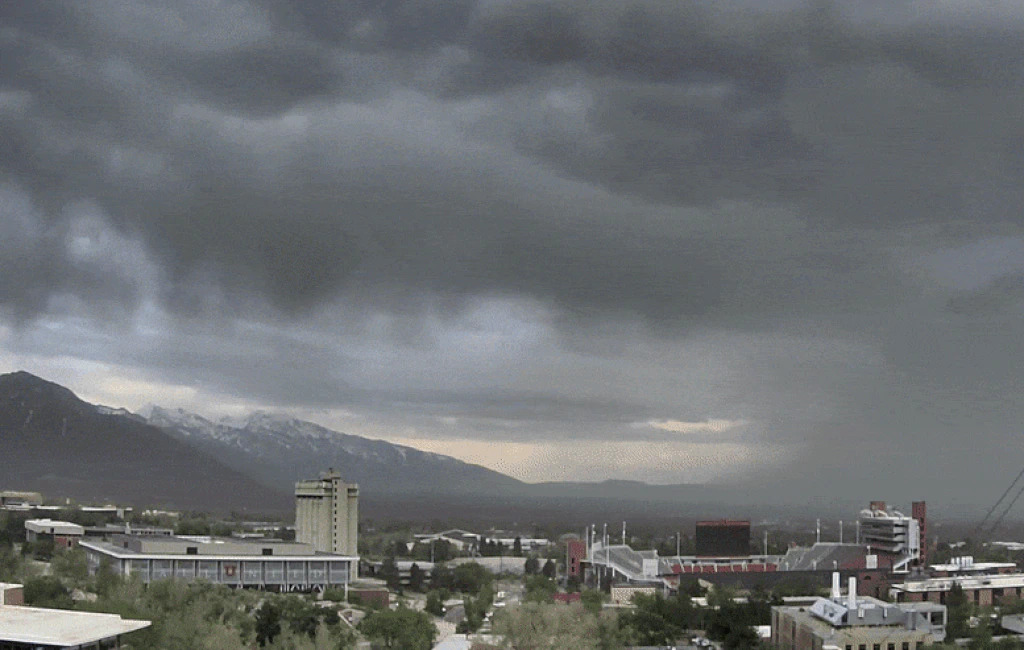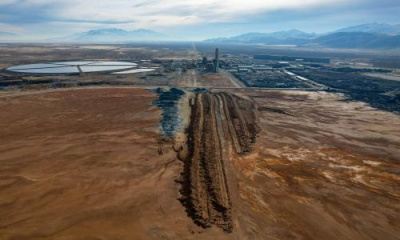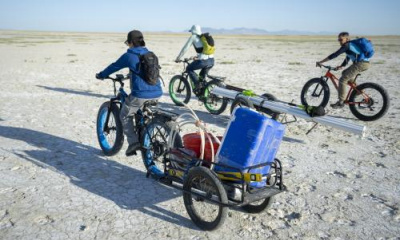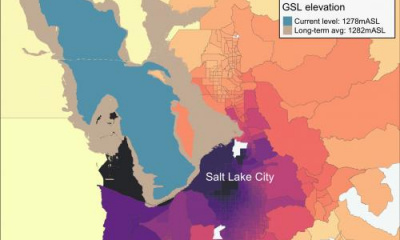The Wasatch Front will continue to get pummeled until the lake reaches a sustainable level.
After historic snowfall over the winter, Utahns are breathing a sigh of relief about the Great Salt Lake. But they’d better not breathe too deeply — it still is blowing an immense amount of dangerous dust pollution along the Wasatch Front.
The lake is at 4,193.4 feet above sea level as of Thursday. That’s about five feet higher than when it bottomed out at an all-time low in November. The lake needs to swell another six feet or so, however, before it reaches an elevation that will allow it to rise and fall, as salty terminal lakes do, without posing a threat to industry, wildlife and public health.
“It doesn’t matter which way the winds are blowing, someone’s being impacted by dust from the Great Salt Lake,” said Derek Mallia, a research assistant professor at the University of Utah’s Department of Atmospheric Sciences.
And while this spring’s runoff has already been substantial, it won’t be enough to stop the dust.
Salt Lake City got blasted during an evening storm Wednesday, as seen on an eerie time-lapse captured by the U.’s MesoWest cameras.
“We had dust being kicked up across the Great Salt Lake,” Mallia said. “It looked like it was probably Farmington Bay, which would make sense since most of that part of the Great Salt Lake is exposed.”
Downdrafts from the storm generated winds clocking in at up to 50 miles per hour near the Salt Lake airport.
“Unfortunately, it’s difficult to estimate how much dust was being kicked up,” Mallia said. “You’d have to run some type of numerical model. But nonetheless, the air quality looked pretty bad.”
Dust pollution is harmful on its own, ravaging the lungs, flaring up asthma and causing inflammation. The lake’s sediment also contains dangerous materials like arsenic and other heavy metals. The impact those pollutants are having on Wasatch Front residents remains unknown.
The lake will need to rise to about 4,200 feet for Farmington Bay to become submerged again.
Dust-generating winds usually happen in the spring and fall, Mallia explained, and they can come from the north and south. When they come from the south and southwest, they blow dust from the dry Sevier Lake into the Salt Lake Valley, while also blowing Great Salt Lake dust into Weber, Davis and Box Elder counties.
When the storms come from the north and northwest, Great Salt Lake dust billows across the Salt Lake Valley. Scientists at the U., including Mallia, have run projections to understand where pollution from these particular storms is the worst. They found it has an outsized impact on the valley’s west side, and Wednesday’s storm fit that pattern.
“Looking at videos, it looked like [dust] deposited over West Valley,” Mallia said, “although it seems the plume started going to the eastern part of the valley as well.”
Salt Lake County’s west side communities already grapple with disproportionate environmental impacts, from mining activities to air pollution. It is a hub of traffic from the airport, idling trains and trucking in the massive warehouse district forming around the Utah Inland Port’s jurisdictional area.
“Long story short, it does seem like there’s an environmental justice issue there for sure,” Mallia said, who is working on a report further exploring his dust projections and their impacts.
The U.S. Environmental Protection Agency is working on an environmental justice study of Salt Lake City’s west side, one of its first such reviews.
State air quality monitoring equipment saw a spike in fine PM 2.5 pollution at 7 p.m. Wednesday, when sensors detected 30 micrograms per cubic meter for a period of about an hour. By comparison, air quality exceeds federal regulatory standards when PM 2.5 hits 35 micrograms, but that’s averaged over a 24-hour period.
“The average over the day was probably not that high,” said Chris Pennell, technical analysis manager for the Utah Division of Air Quality. “I think the visibility was the most concerning thing ... I personally was driving at 7 o’clock.”
Still, dust pollution is typically measured by the coarser PM 10 particulate, which the state isn’t as well-equipped to track. And those larger particles are likely what contain harmful heavy metals, Pennell said.
“What we’re trying to do right now is figure out exactly what kind of toxic compounds are in PM 10 and create a database we can share with other researchers,” he said. “This obviously is an area of concern, and we share that concern.”
This last session, Utah lawmakers set aside $232,000 in one-time funds and $44,000 ongoing to help state regulators track dust blowing off the lake, along with the dangers it contains.
DAQ scientists like Pennell are studying wind patterns to understand where to place instruments around the Great Salt Lake and better capture its blowing exposed lakebed.
“We don’t establish health standards here at DAQ, we monitor data,” Pennell said. “So what we’re trying to do here is monitor data, so health implications can be established further down the road.”









